
ANALOG Devices has been given the go-ahead to develop a planned expansion on its Raheen site, following a decision from An Bord Pleanála.
The plans for Analog’s expansion were previously appealed by neighbouring landowner, farmer, and former Limerick senior hurling manager Tom Ryan, citing concerns over the maintenance of the water course on the Loughmore Canal. Mr Ryan maintained that the development would lead to flooding on his lands.
Analog’s plans included the construction of a two-storey over basement extension to the existing production line building, as well as a two-storey extension to the existing energy centre on the site in the Raheen Industrial Estate.
The development would also consist of a reorganisation of the site layout, as well as the relocation of 300 parking spaces from Ballynoe Avenue to a new landscaped site on the Derrybeg Road.
Limerick City and County Council planners granted permission for the development back in September 2022, after which it was appealed to An Bord Pleanála (ABP).
Despite the appeal, ABP decided to grant the permission, subject to nine conditions.
The conditions concerned hours that development can take place on the site, and that a survey of the existing storm water network within the site be carried out to ensure surface water run off is disposed of properly.
Analog Devices currently employ over 1,350 people on the site in Raheen, and it is understood that this development would create 70 new jobs.
The company also have another planning application before Limerick City and County Council, which would result in a €630million investment in the site if granted permission.
The investment would add 600 employees to the site, adding to the 1,500 workers already employed by the firm across Ireland.
The company applied to the Council seeking permission to demolish part of the existing building in the Raheen Industrial Estate, as well as submitting a separate application for change of use of parts of the building.
The development would look to demolish parts of an existing industrial building, changing its use from industrial to office use, along with the addition of a mezzanine level in the existing building and facade works.
A new two or three-storey building would also be constructed, which would feature offices, high-tech research and laboratory spaces, meeting rooms, a reception area, canteen, employee gym, and social spaces.
A decision on that application is due later this month.









